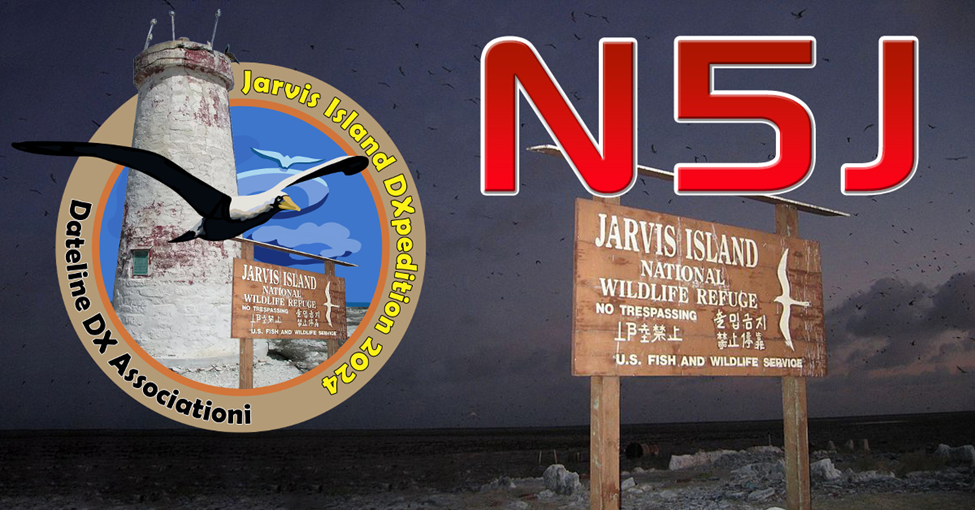
The 100% RIB (Rig in a Box) N5J operation from the Jarvis Island National Wildlife Refuge, one of the rarest DXCC entities on the planet, is scheduled for a two-week run from August 5-20, 2024. The operating team will consist of Don Greenbaum, N1DG; Mike Snow, KN4EEI; Tomi Pekarik, HA7RY; and Rig in a Box innovator George Wallner, AA7JV. All four operators were also part of the DX Engineering-sponsored Baker Island KH1/KH7Z DXpedition in 2018.
Uninhabited Jarvis Island, which features a dried lagoon where guano deposits were mined in the nineteenth century, is an unincorporated, unorganized U.S. territory administered by the U.S. Fish and Wildlife Service (USFWS) of the U.S. Department of the Interior as part of the National Wildlife Refuge (NWR) system. Jarvis was declared a NWR in 1974. In 2009, President George W. Bush designated Jarvis Island as part of the Pacific Remote Islands Marine National Monument. It is 1,305 nautical miles south of Honolulu.
Incredibly Rare
How rare is a Jarvis Island activation? Very is an understatement. Consider that it hasn’t been active since the April 1990 AH3C/KH5J DXpedition, which logged 55,000 QSOs over ten days. The only other time Jarvis has been QRV was AD1S/KH5 in November 1983—the first time this 1.7-square-mile coral island in the South Pacific was on the air. AD1S/KH5 recorded 16,800 QSOs, which, when added to the QSOs made during the last DXpedition there 34 years ago, doesn’t amount to a mountain of contacts. But because Jarvis Island is a dual entity with the rare but more frequently visited Palmyra Atoll—about 450 miles to the northwest—Jarvis/Palmyra ranks as #18 globally and #9 in Europe on Clublog’s Most Wanted List. Read this fascinating article by Hal, W8HC, about some of Palmyra’s history and the DX Engineering-supported K5P January 2016 DXpedition to the atoll.
Why So Rare?
It’s no secret in the ham community that getting permission from government gatekeepers to put boots—as well as antennas, tents, and other gear—on wildlife protected locales like Jarvis has been a challenge, to say the least. The Rig in a Box concept, which allows hams to operate remotely through self-contained stations set up on land, seems to be finding a more receptive audience with those who make the decisions regarding whether or not to permit DXpeditions to highly restricted lands.
In the case of Jarvis, government entities also wanted to ensure that the mission of the wildlife refuge was compatible with the mission of the ham radio operators. After negotiations that began in 2021, assurances that the DXpedition would have limited environmental impact, and the decision to combine N5J’s ham radio activity with scientific research, the team was granted a Special Use Permit for operation on the reserve.
The U.S. Fish and Wildlife Service notes that the Jarvis Island National Wildlife Refuge is home to numerous shore and seabirds, including the brown booby, masked booby, red-footed booby, and blue-gray noddy; more than 250 species of fish; manta rays; sea turtles; and “some of the most remote coral reefs in the world,” per its website.
N5J organizers hope a successful activation of Jarvis Island will open the door for other rare DXpeditions in which leaving a minimal footprint is an imperative. N5J plans to have six RIB stations on the island—two for local operation from a boat and the others for remote operation through multiple operators around the world via Starlink. Chasers will be able to reach operators on 160-6M in SSB, CW, and FT8.
From the Jarvis DXpedition website: “The use of the RIB concept and our agreement to take three scientists with us to allow USFWS to conduct needed research on the island were the factors making this possible. Our organization wishes to thank the management of the Pacific Remote Marine National Monument for their efforts in making this possible.”
For much more about the Rig in a Box concept, watch Tim Duffy, K3LR, DX Engineering CEO, interview RIB creator and N5J operator AA7JV:
For up-to-date details about Jarvis Island N5J, visit their official website.
DX Engineering Lends Its Support
In DX Engineering’s ongoing mission to stand beside hams who are putting rare DXCC entities on the air, the company contributed a range of gear to complement the RIB setups:
- DX Engineering DXE-ATK65A Telescoping Aluminum Antenna Tubing Kits: The kit comes with 11 six-foot sections and one three-foot section of DX Engineering’s rugged 6063-T832 drawn aluminum tubing. The kit also includes all required stainless steel element clamps. The overall length of the assembled sections can reach up to 65 feet.





- Mastrant-R Support and Guy Line Rope, 220 Lb. Break Strength, 1,650-Foot Roll (find many more Mastrant options at DXEngineering.com.)

Look for many more details at OnAllBands about Jarvis Island N5J in the days ahead. And stay tuned—OnAllBands will be featuring the equally rare one-operator (FT4GL) activation of Glorioso Islands, May 24-June 19, later this month. The 160-6M operation will include the use of VA6AM band pass filters provided by DX Engineering.

